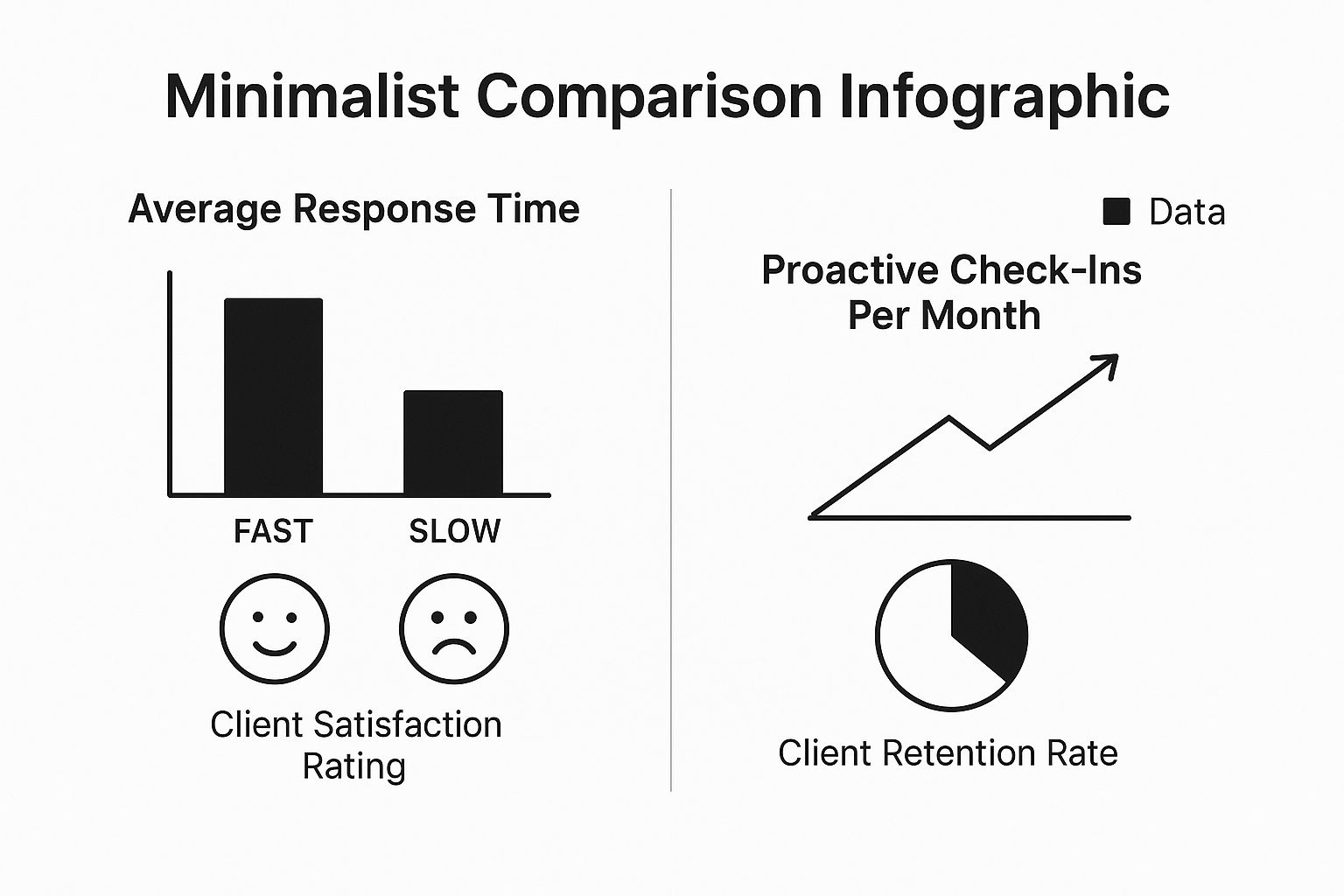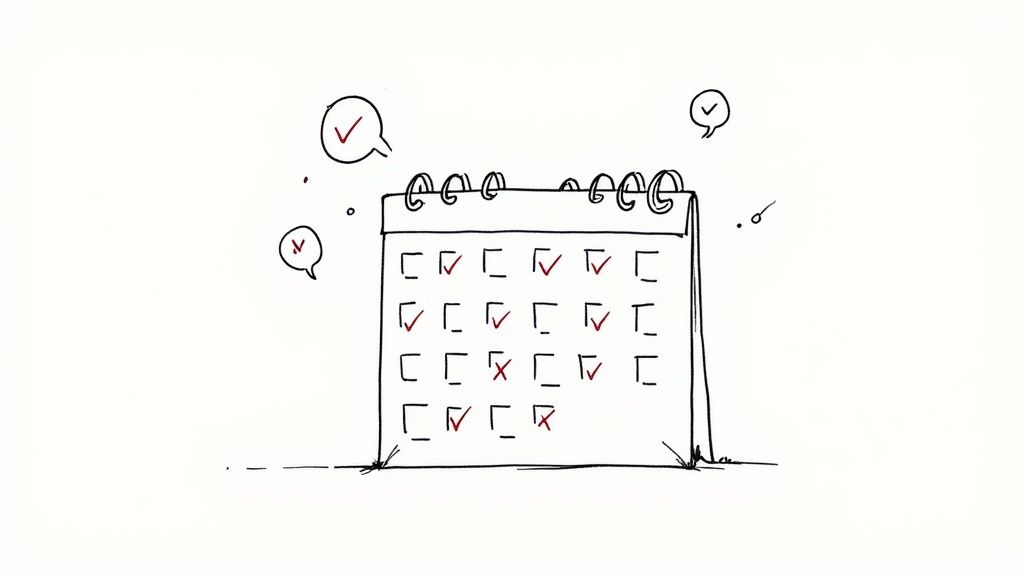
How to Build Client Relationships: Tips for Lasting Success
Published
Building strong client relationships isn't just a "nice-to-have" in business; it's a core strategy that directly fuels your bottom line. I've learned over the years that the secret sauce boils down to three key things: consistently communicating, delivering value that goes beyond the contract, and earning their absolute trust. When you make the shift from a purely transactional mindset to a relational one, everything changes for the better.
Why Client Relationships Are Your Greatest Asset
Forget the endless, costly chase for new leads. The most sustainable and profitable growth comes from nurturing the clients you already have. In the influencer marketing world, campaigns are complex with a ton of moving parts. A solid client relationship is your best insurance policy against things going sideways. It's what turns a one-off project into a long-term, lucrative partnership.
This isn't just about being friendly—it's a calculated business approach that pays real dividends. When clients truly trust you as a partner, they're far more likely to:
- Bring you repeat business: Why would they look elsewhere when they know you deliver?
- Refer new clients: A happy client is your most powerful and credible marketing tool.
- Be more forgiving when issues pop up: Trust creates a safety net. It allows you to solve problems together, rather than playing the blame game.
- Greenlight bigger, more ambitious projects: They stop seeing you as a vendor and start seeing you as a strategic partner essential to their success.
The Financial Impact of Strong Bonds
The numbers paint a very clear picture. Despite all the obvious benefits, it's shocking how many businesses drop the ball here. A 2023 report found that only 19% of companies planned to actively focus on relationship marketing. This is a massive missed opportunity, especially when you consider that keeping a client is up to 5 times cheaper than finding a new one.
Even more compelling? A small 5% increase in customer retention can boost profits by an incredible 25% to 95%. The financial argument is undeniable.
This infographic really drives home the link between simple, proactive communication and keeping clients for the long haul.

As you can see, making a proactive effort dramatically improves both satisfaction and loyalty. Understanding the key elements of successful customer relationship management is the first step to truly grasping why these relationships are your most valuable asset.
Transactional vs. Relational Approach to Clients
Shifting your mindset is the most crucial step. A transactional view focuses on the immediate gain, while a relational view invests in long-term partnership. Here’s a breakdown of how those two mindsets play out in the real world.
| Aspect | Transactional Approach | Relational Approach |
|---|---|---|
| Primary Focus | Closing the current deal | Building a long-term partnership |
| Communication | Reactive; only when necessary | Proactive; regular check-ins and updates |
| Problem Solving | Blame-oriented; focused on contract terms | Collaborative; focused on finding a solution |
| Value | Limited to the scope of work | Exceeds expectations; offers strategic advice |
| Outcome | One-off projects; high client churn | Repeat business; strong loyalty and referrals |
The table makes it clear: a relational approach requires more upfront effort but yields far greater returns over time. It's about playing the long game.
I always tell my team that the core principle is simple: move from a "What can I get?" mindset to a "What can I give?" approach. This shift in perspective is what separates fleeting transactions from enduring, profitable partnerships that fuel long-term success.
Ultimately, every email you send, every check-in call you make, and every campaign report you deliver is an opportunity to strengthen that bond. In a field like influencer marketing, where personality and brand alignment are everything, mastering this skill is simply non-negotiable. For a deeper dive into how this applies to creators, you can check out our complete guide on https://influencermarketingjobs.net/blog/influencer-relationship-management.
Nail the First Impression with Strategic Onboarding

You never get a second chance to make a first impression. In our world, that first onboarding experience sets the stage for the entire relationship. A clunky or confusing start immediately plants seeds of doubt and can create friction that’s hard to recover from. To build relationships that truly last, you have to do more than just send a welcome email; you need to design an onboarding process that shows them they made the right choice.
This is your first, best shot to prove you're organized, on the ball, and genuinely invested in their success. A tight, structured process shows you're a professional who doesn't leave things to chance. For a strong start that lays the groundwork for a successful partnership, it's essential to follow established client onboarding best practices.
Develop a Shared Success Roadmap
Before a single deliverable is touched, I sit down with every new client to build what I call a "Success Roadmap." This isn't just a rehash of the contract or scope of work. It’s a living, breathing document we create together to make sure everyone is aligned from the absolute beginning.
Think of it as the blueprint for your partnership. It should clearly spell out:
- Their Core Business Goals: What is the real-world business result they’re after? Is it to bump up qualified leads by 15%? Or maybe to improve brand sentiment across social media? Get specific.
- Key Performance Indicators (KPIs): How will we actually measure success? Pin this down with concrete metrics like engagement rates, click-throughs, or specific deliverable milestones.
- Our Communication Rhythm: How and when will we talk? Let's decide now. A weekly 30-minute sync-up call? A bi-weekly performance report sent every other Friday? Setting this cadence early prevents so much guesswork.
- Key People and Their Roles: Who is my main point of contact? Who is the ultimate decision-maker that needs to sign off on creative? Nailing this down avoids endless email chains and approval delays.
Creating this roadmap as a team completely changes the dynamic. It shifts the conversation from, "Here's what I'll do for you," to, "Here's what we'll achieve together." That sense of shared ownership is the foundation of a real partnership.
Run a Partnership-Focused Kickoff Call
The kickoff call should feel less like a stuffy briefing and more like the official launch of a great partnership. Your goal isn't just to review a document; it's to build excitement and make them feel even better about their decision to hire you.
I always start the meeting by repeating their main goals back to them. It’s a simple act, but it instantly shows you’ve been listening and are already zeroed in on what they care about most. Then, walk them through the Success Roadmap section by section, encouraging questions to make sure you're both on the exact same page. This call is also the ideal moment to iron out any final details of your working agreement. Having crystal-clear terms from day one is non-negotiable, and our guide on contract negotiation strategies is a great resource for getting these agreements locked in.
By putting real effort into a strategic onboarding process, you head off misunderstandings before they can even start. You position yourself not as just another vendor on their expense sheet, but as an essential partner they can't imagine working without.
Master Proactive and Transparent Communication
 Exceptional communication is the bedrock of any solid client relationship. I'm not just talking about being responsive—I'm talking about being proactive and relentlessly transparent. If you're constantly in a reactive, fire-fighting mode, you’ll always be on the defensive. But when you establish a proactive rhythm, you shift from being just another vendor to becoming an indispensable partner.
Exceptional communication is the bedrock of any solid client relationship. I'm not just talking about being responsive—I'm talking about being proactive and relentlessly transparent. If you're constantly in a reactive, fire-fighting mode, you’ll always be on the defensive. But when you establish a proactive rhythm, you shift from being just another vendor to becoming an indispensable partner.
The aim here is simple: provide updates before your client even has a chance to ask for them. This single act builds an incredible amount of trust. It shows you're not just checking boxes but actively steering their campaign, managing their investment, and thinking two steps ahead.
Establish a Predictable Communication Cadence
Right from the kickoff call, you need to set a clear and predictable schedule for communication. This eliminates guesswork and helps the client feel confident that they’ll always be in the loop. The "right" cadence really depends on the project's complexity and the client's own preferences, but a few tried-and-true methods work well.
Here are a few rhythms I've seen succeed:
- Weekly Summary Emails: A crisp, bullet-point email that lands in their inbox every Friday afternoon is often perfect for keeping stakeholders informed without overwhelming them.
- Bi-Weekly Progress Reports: For campaigns that span several months, a more detailed report every two weeks can effectively showcase performance data, celebrate wins, and map out what's coming next.
- Quick Sync Calls: A standing 15-minute call every Tuesday morning can cut through a dozen back-and-forth emails and resolve issues on the spot.
The key is consistency. When a client knows, without a doubt, that they will hear from you with a full update every Friday at 4 PM, they stop worrying. That predictability is the secret sauce for building client relationships that truly last.
Once you’ve set a rhythm, treat it like a sacred commitment. What you put in these updates matters just as much. Aim for a healthy mix of celebrating successes while being upfront about challenges. Never try to hide the bumps in the road. Instead, present them along with a proposed solution.
Navigating Tough Conversations with Honesty
Let's be real—even the most perfectly planned campaigns can hit a snag. Scope creep, a missed deadline, or an influencer who isn't performing are all part of the job. It's how you manage these moments that will define your partnership. My advice? Always be direct, honest, and laser-focused on the solution.
For example, what happens when a client asks for something outside the agreed-upon scope? Don't just shut them down. Frame it as a new opportunity. You might say, "That's a fantastic idea, and I think it could really add value. It's just outside what we scoped for this phase, but I'm happy to put together a quick proposal for us to look at." This validates their idea while protecting your work boundaries. Our guide on professional email writing tips has some great templates for wording these conversations.
When the bad news is on your end—say, a deliverable is delayed—you have to get out in front of it. Don't wait for the client to notice. Proactively reach out, explain the situation clearly and concisely, take full ownership, and immediately present your plan to get things back on track. This kind of transparency can turn a potential disaster into a moment that actually builds trust, proving you’re a partner they can count on when things get tough.
It's Not About Automation, It's About Empathy at Scale
Technology in client services gets a bad rap. People think it’s cold, impersonal, and a poor substitute for a real conversation. But that’s a complete misunderstanding of its role.
When used correctly, technology isn’t meant to replace human connection—it’s meant to amplify it. It acts as an assistant, helping you be more present, personal, and proactive, especially when you're juggling a dozen campaigns at once. Think of it as your second brain, keeping track of the details so you can focus on the relationship.
This isn’t just a nice idea; it’s a massive shift in how business gets done. The global market for Customer Relationship Management (CRM) tools is hovering between USD 70.2 billion and USD 101.4 billion in 2024, and it's only getting bigger. A staggering 80% of organizations now rely on a CRM for reporting and automation, making it a non-negotiable for anyone serious about tracking client interactions. You can dig into the numbers yourself in this market analysis from Grand View Research.
Stop Forgetting the Little Things
A CRM shouldn't be a glorified digital address book. Its real magic is helping you remember the small details that show a client they’re more than just an entry on your spreadsheet. This is how you build loyalty.
What kind of details? Things that actually matter to them:
- Business Anniversaries: A quick "Congrats on 5 years!" email goes a long way. It shows you’re paying attention.
- Project Milestones: Remember that big product launch you helped with six months ago? Acknowledge it.
- Personal Notes: Did they mention their kid was graduating or that they were training for a marathon? Make a note. A quick "How did the marathon go?" on your next call is how you build a genuine rapport.
This isn’t about being nosy. It’s about being thoughtful. Remembering these details makes clients feel seen and valued, which is the bedrock of trust.
I call our CRM an "empathy engine." It automates the rote tasks so my brain can focus on strategy and creative problem-solving for my clients. It handles the remembering so I can focus on the connecting.
Automate the Task, Not the Relationship
Look, automation is a game-changer, but only if you use it right. The goal is to automate the mundane, repetitive tasks that eat up your day—not the relationship itself. Freeing yourself from administrative busywork gives you the mental space for the high-value, strategic conversations that clients actually pay you for.
Here are a few simple automations that can create huge wins:
- Routine Check-ins: A month after a project ends, an automated email can ask how the results are holding up. It’s a simple touchpoint that keeps the conversation going.
- Content Sharing: See a new article that’s perfect for a client’s industry? An automated alert can remind you to forward it with a quick, personal note.
By letting technology handle the low-touch tasks, you save your energy for the conversations that really count. This shows you’re not just a vendor, but a partner who is genuinely invested in their success.
Turn Setbacks into Relationship Strengths

Let's be real: things will go wrong. No matter how meticulously you plan, campaigns hit snags and mistakes happen. It’s a stressful part of the business, but these moments are also where you truly define your partnership. Adversity is the forge where genuine, long-lasting client relationships are built.
Believe it or not, a well-handled crisis can build far more trust and loyalty than if a project had gone perfectly from the start. It’s a golden opportunity to show your accountability, your problem-solving chops, and your unwavering commitment to the client's success. This is how you prove you're a partner, not just another vendor. By actively implementing strategies to reduce churn and cultivate loyalty even when challenges pop up, you can turn a negative into a major positive.
Own the Mistake Immediately
The second you realize something's off track, your next move is everything. Don't hide it. Don't point fingers. And please, don't just hope the client won't notice—they always do. The only way forward is to take immediate and full ownership.
Get out in front of the problem by reaching out proactively. A simple, direct admission like, "I'm calling because I dropped the ball on X, and I want to walk you through exactly how I'm fixing it," is incredibly powerful. That kind of raw honesty completely disarms tension and instantly shifts the dynamic from blame to resolution.
Communicate a Clear Resolution Plan
Saying "my bad" is just step one. It's meaningless without a concrete plan to back it up. Your client needs to see that you have a clear-headed strategy to make things right, and to do it quickly.
Your resolution plan should be direct and to the point. I've always found this framework works best:
- What Happened: A brief, factual summary of the issue. No excuses.
- The Solution: The specific steps you’re taking right now to correct it.
- The Timeline: A realistic estimate of when they can expect a full resolution.
- Prevention: The measures you're putting in place to ensure this never happens again.
Presenting this framework shows you’re in control, even when things have gone sideways. It replaces your client’s anxiety with confidence in your ability to manage the situation.
The key takeaway here: Focus on a fair outcome for the client, not just on fixing the immediate error. This might mean offering a discount on the next invoice, throwing in a value-add at no cost, or dedicating extra hours to get the project back on track and actually exceed their original expectations.
If we learned anything from the COVID-19 pandemic, it was the importance of resilience in managing client relationships. When in-person meetings disappeared overnight, the companies that thrived were the ones who leaned into technology to stay connected. They adapted quickly, and as a result, saw better client retention. It was a massive, real-world lesson proving that strengthening relationships through adversity is essential for growth.
Common Questions About Building Client Relationships
Even with the best strategies in place, client relationships can throw some curveballs. You're bound to run into situations that make you pause and wonder, "What's the right move here?" This is where experience really counts. I've gathered some of the most common questions that pop up, especially when things get tricky, and broken them down with real, actionable advice.
How Do I Rebuild Trust After a Mistake?
We’ve all been there. A campaign miss, a reporting error, a miscommunication. Your stomach drops. The absolute worst thing you can do is try to downplay it or, even worse, hide it. The key is to take immediate and total ownership.
Get on the phone or a video call—this isn't a time for email. Acknowledge the mistake, explain what happened without a single excuse, and immediately present a clear, step-by-step plan to make it right. Instead of a vague "we're sorry," say, "Here's exactly what went wrong, and here are the three things we are doing right now to fix it."
Once you’ve laid out the plan, you have to execute it flawlessly and then some. After the fix is in place, circle back. Don't wait for them to ask. Proactively follow up to confirm they're satisfied with the solution. Trust isn't rebuilt with a single apology; it's earned back through consistent, reliable action over time.
What Is the Best Way to Handle a Demanding Client?
First, it helps to understand the "why." More often than not, a client becomes "demanding" when they feel uninformed or anxious about the project's direction. They feel out of control, so they try to micromanage.
Your first move is to gently guide the conversation back to the facts and the plan you both agreed on. Referencing your shared Success Roadmap or the initial scope of work is a non-confrontational way to realign expectations. It’s not about pointing fingers; it’s about getting back on the same page.
Setting firm but friendly boundaries is everything. Your best defense, however, is a good offense. Proactive communication is your secret weapon. When clients hear from you regularly with updates and progress reports, they feel in the loop and have far less reason to become demanding.
How Can I Show Appreciation Without Being Cheesy?
Forget the generic gift baskets and branded swag. Real appreciation is personal. It shows you're listening. Thoughtful, sincere gestures will always mean more than a pricey gift that feels like a line item on your marketing budget.
Think smaller and more specific.
- Did they mention their kid’s soccer tournament on a call? Ask how it went next time you talk.
- Stumble upon an article about a competitor's new strategy? Send it over with a note like, "Saw this and thought of your Q3 goals."
- Can you offer a small, unprompted value-add? Maybe it's a quick analysis of a new social feature or an introduction to a potential partner.
These small acts show you see them as a partner in success, not just an account number.
Is It Worth Investing Time in a Low-Paying Client?
This is a tough one, and it requires you to think beyond the current invoice. It's less about what they're paying you today and more about their strategic value for tomorrow.
Before you decide, ask yourself a few critical questions:
- Is their brand a respected name in an industry you're trying to penetrate?
- Do they consistently send high-quality referrals your way?
- Does working with them allow you to build a powerful case study for a service you want to grow?
If the answer to any of these is a resounding "yes," then nurturing that relationship might be a smart long-term play. But be honest with yourself. If they are a constant drain on your team's morale and time with no clear strategic upside, it might be time to professionally and politely part ways. Freeing up that energy for more fruitful partnerships is a critical business decision.
Ready to find your next great role in the influencer marketing space? At Influencer Marketing Jobs, we connect talented professionals like you with top-tier opportunities. Explore our job board today and take the next step in your career.